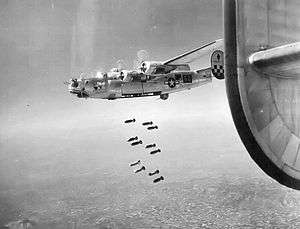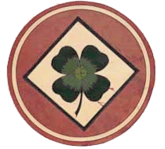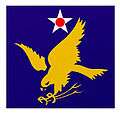759th Bombardment Squadron
The 759th Bombardment Squadron is an inactive United States Air Force unit. The squadron was organized in July 1943 as a Consolidated B-24 Liberator unit. After training in the United States, it moved to Italy, where it engaged in the strategic bombing campaign against the Axis, earning a Distinguished Unit Citation for an attack on an aircraft factory in Austria. it was inactivated after returning to the United States.
| 759th Bombardment Squadron | |
|---|---|
 459th Bombardment Group B-24 Liberator attacking a target | |
| Active | 1943–1945; 1947–1951 |
| Country | |
| Branch | |
| Role | Bombardment |
| Engagements | Mediterranean Theater of Operations[1] |
| Decorations | Distinguished Unit Citation[1] |
| Insignia | |
| 759th Airlift Squadron emblem (approved 31 July 1944)[1] |  |
The squadron was activated in the reserve at Davis-Monthan Field, Arizona in 1947, although it is not clear if it was equipped before 1949. At that time it became a corollary of the 43d Bombardment Group, a Strategic Air Command unit flying Boeing B-29 Superfortresses. It was mobilized for the Korean War in May 1951. After its personnel were transferred to other units, it was inactivated on 16 June 1951.
History
World War II
The squadron was first activated on 1 July 1943 at Alamogordo Army Air Field, New Mexico as the 759th Bombardment Squadron, one of the four original squadrons of the 459th Bombardment Group. The squadron trained with Consolidated B-24 Liberators under Second Air Force Until October, when it moved to Westover Field, Massachusetts.[1][2] The squadron flew long-range convoy escort missions over area between the Newfoundland Banks and Long Island Sound in November and December 1943 while Giulia Airfield, its station in Italy, was being constructed. In January 1944, the squadron began its overseas movement.[1]
The squadron arrived in Italy in February 1944 and began flying combat missions in March.[2] The squadron engaged in very long range strategic bombing missions to enemy military, industrial and transportation targets in Italy, France, Germany, Austria, Hungary, Romania, and Yugoslavia, bombing railroad marshalling yards, oil refineries, airfields, heavy industry, and other strategic objectives. In April 1944, the 459th Group led the 304th Bombardment Wing in an attack on an airfield and aircraft factory at Bad Voslau, Austria through heavy flak and fighter attacks. The squadron was awarded a Distinguished Unit Citation for this action.[1][2]
In addition to strategic missions, the squadron also carried out support and interdiction operations. In March 1944, the squadron attacked railroads used to supply enemy forces surrounding the Anzio beachhead. In August, it struck bridges, harbors, and troop concentrations to aid Operation Dragoon, the invasion of Southern France. It also hit communications lines and other targets during March and April 1945 to support the advance of British Eighth Army and American Fifth Army in northern Italy.[2]
The squadron returned to the United States in August 1945, being programmed for deployment to the Pacific Theater as a Boeing B-29 Superfortress very heavy bombardment squadron. A cadre reformed at Sioux Falls Army Air Field, South Dakota in the middle of the month. The Japanese surrender in August led to the inactivation of unit on 28 August.[1]
Reserve operations
The 759th was activated as a reserve unit at Davis-Monthan Field, Arizona in April 1947, although its parent 459th Group was located at Long Beach Army Air Field, California. Although nominally a heavy bomber unit, it is not clear whether the squadron was equipped with operational aircraft prior to 1949.[3] The rest of the 459th Group at Long Beach trained with North American T-6 Texans and Beechcraft T-7 Navigators and T-11 Kansans[4][5][6] The squadron trained under the supervision of the 419th AAF Base Unit (later the 2348th Air Force Reserve Flying Training Center).[7]
President Truman’s reduced 1949 defense budget required reductions in the number of units in the Air Force.[8] ConAC also reorganized its reserve units under the wing base organization system in June 1949, making the 459th Group and its squadrons at Long Beach surplus. However, the May 1949 Air Force Reserve program called for a new type of unit, the corollary unit, which was a reserve unit integrated with an active duty unit. The plan called for corollary units at 107 locations. It was viewed as the best method to train reservists by mixing them with an existing regular unit to perform duties alongside the regular unit.[9] The 459th Group headquarters moved without personnel or equipment to Davis-Monthan and the group and squadron became corollaries of Strategic Air Command (SAC)'s 43d Bombardment Group, a B-29 unit. Along with all other reserve corollary units, the group was mobilized for the Korean War.[10] Once the squadron was mobilized in May 1951 SAC reassigned its personnel to other units and the unit inactivated the following month.[1]
Lineage
- Constituted as the 759 Bombardment Squadron (Heavy) on 19 May 1943
- Activated on 1 July 1943
- Redesignated 759 Bombardment Squadron, Heavy on 29 September 1944[11]
- Inactivated on 28 August 1945
- Redesignated 759 Bombardment Squadron, Very Heavy on 11 March 1947
- Activated in the reserve on 19 April 1947
- Redesignated 759 Bombardment Squadron, Medium on 26 June 1949
- Ordered to active service on 1 May 1951
- Inactivated on 16 June 1951[12]
Assignments
- 459th Bombardment Group, 1 July 1943 – 28 August 1945
- 459th Bombardment Group, 19 April 1947 – 16 June 1951[1]
Stations
|
|
Aircraft
- B-24 Liberator, 1943-1945[1]
Awards and campaigns
| Award streamer | Award | Dates | Notes |
|---|---|---|---|
| Distinguished Unit Citation | 23 April 1944 | Bad Voslau, Austria 759th Bombardment Squadron[1] |
| Campaign Streamer | Campaign | Dates | Notes |
|---|---|---|---|
| Air Offensive, Europe | 12 February 1944–5 June 1944 | 759th Bombardment Squadron[1] | |
| Air Combat, EAME Theater | 12 February 1944–11 May 1945 | 759th Bombardment Squadron[1] | |
| Rome-Arno | 12 February 1944–9 September 1944 | 759th Bombardment Squadron[1] | |
| Central Europe | 22 March 1944–21 May 1945 | 759th Bombardment Squadron[1] | |
| Normandy | 6 June 1944–24 July 1944 | 759th Bombardment Squadron[1] | |
| Northern France | 25 July 1944–14 September 1944 | 759th Bombardment Squadron[1] | |
| Southern France | 15 August 1944–14 September 1944 | 759th Bombardment Squadron[1] | |
| North Apennines | 10 September 1944–4 April 1945 | 759th Bombardment Squadron[1] | |
| Rhineland | 15 September 1944–21 March 1945 | 759th Bombardment Squadron[1] | |
| Po Valley | 3 April 1945–8 May 1945 | 759th Bombardment Squadron[1] |
References
Notes
- Maurer, Combat Squadrons, pp. 740-741, except as noted.
- Maurer, Combat Units, pp. 334-335
- See Maurer, Combat Squadrons, pp. 740-741. (not listing any assigned aircraft for the period).
- Robertson, Patsy (16 May 2011). "Factsheet 756 Air Refueling Squadron (AFRC)". Air Force Historical Research Agency. Retrieved 17 November 2017.
- Haulman, Daniel L. (10 February 2012). "Factsheet 757 Airlift Squadron (AFRC)". Air Force Historical Research Agency. Retrieved 3 September 2018.
- Endicott, Judy D. (7 April 2008). "Factsheet 758 Airlift Squadron (AFRC)". Air Force Historical Research Agency. Retrieved 21 June 2018.
- See Mueller, p. 101. (419th stationed at Davis-Monthan).
- Knaack, p. 25
- Cantwell, p. 73
- Cantwell, p. 87
- See Haulman, Robertson and Endicott. (showing redesignation of other squadrons in group).
- Lineage information in Maurer, Combat Squadrons, pp. 740-741, except as noted.
Bibliography
![]()
- Cantwell, Gerald T. (1997). Citizen Airmen: a History of the Air Force Reserve, 1946-1994. Washington, D.C.: Air Force History and Museums Program. ISBN 0-16049-269-6. Retrieved 17 December 2016.
- Knaack, Marcelle Size (1978). Encyclopedia of US Air Force Aircraft and Missile Systems (PDF). Vol. 2, Post-World War II Bombers 1945-1973. Washington, DC: Office of Air Force History. ISBN 0-912799-59-5. Retrieved 17 December 2016.
- Maurer, Maurer, ed. (1983) [1961]. Air Force Combat Units of World War II (PDF) (reprint ed.). Washington, DC: Office of Air Force History. ISBN 0-912799-02-1. LCCN 61060979. Retrieved 17 December 2016.
- Maurer, Maurer, ed. (1982) [1969]. Combat Squadrons of the Air Force, World War II (PDF) (reprint ed.). Washington, DC: Office of Air Force History. ISBN 0-405-12194-6. LCCN 70605402. OCLC 72556.
- Mueller, Robert (1989). Air Force Bases, Vol. I, Active Air Force Bases Within the United States of America on 17 September 1982 (PDF). Washington, DC: Office of Air Force History. ISBN 0-912799-53-6. Retrieved 17 December 2016.


.svg.png)
